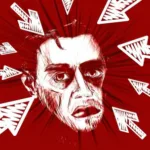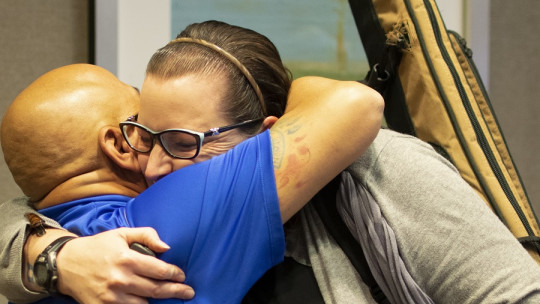“Mr. Rodrigo comes into my psychology consultation. He tells me that he has not had the desire to live for a long time: he has been sad for a long time, that he does not feel like doing anything nor does he see anything that could make him the least bit excited. Even things that he was once passionate about are now just a mere nuisance. In addition to this, he indicates that he does not see the situation improving at any time, having considered being a hindrance to his loved ones.
At first they behaved well with him, but over time they got tired of him, and now he is alone. From what he says, together with the results obtained from the various tests and evaluation measures that I apply, everything suggests that we are facing a case of major depressive disorder. However, the time has come to ask myself, what can I do as a professional to help him improve his situation?
Analyzing the case: depression
Depression. This word is commonly used, in everyday language, to refer to a state of sadness that remains for a period of time. However, this use of the concept in everyday language misses much of what the term implies on a clinical level.
Clinically, the presence of a major depressive disorder is considered the presence of depressive episodes for at least two weeks in a row, which They are defined by the presence of five symptoms, one of them being a sad mood and/or the presence of apathy. (lack of motivation/interest) or anhedonia (absence of pleasure). Other symptoms include changes in appetite/weight, fatigue, agitation or slowness, guilt, and thoughts of suicide. To be considered as such, it must interfere with daily life and not be due to other disorders, such as psychotic disorders. It is one of the most common mood disorders in the population.
Although these are the typical symptoms of depression, it is worth asking: how to interpret and treat it?
Treating depression
There are numerous models that attempt to explain the depressive process and its causes. This wide diversity means that fortunately there are a large number of techniques available to treat depression. One of the well-known, successful and currently used ones comes from Beck’s Cognitive Theory.
Beck’s cognitive model
This theory considers that the elements that are most important in depression are the cognitive ones. According to this theory, the main problem of depressed subjects is cognitive distortion when interpreting reality phenomena, focusing attention on knowledge schemes consistent with our cognitions. Due to these schemas and distortions, we have negative thoughts about ourselves, the future that awaits us, and the world around us (thoughts known as the cognitive triad).
Based on this theory, Beck himself designed cognitive therapy in order to treat depression (although it has subsequently been adapted to other disorders).
Beck Cognitive Therapy for Depression
This therapy has been developed so that patients discover more positive ways of interpreting reality. moving away from the depressogenic schemes and cognitive distortions typical of depression.
The aim is to act from a collaborative empiricism in which the patient actively participates in creating situations that allow him to carry out behavioral experiments (that is, to test his beliefs), which will be proposed between the therapist and the patient himself. Likewise, the psychologist will not confront the dysfunctional beliefs directly, but will provide a space for reflection for the patient, so that ultimately he is the one who sees the inaccuracy of his beliefs (this way of proceeding is known as the Socratic).
To act in this area, work will be done using cognitive, behavioral and emotional techniques.
Behavioral techniques
These types of techniques aim to alleviate the lack of motivation and eliminate the passivity of depressed patients. In the same way, they also allow us to test one’s own beliefs of guilt and worthlessness, their basic functioning being the performance of behavioral experiments.
1. Assignment of graded tasks
It is based on the negotiation of the completion of various tasks, graded according to their difficulty. so that the patient can test his beliefs and increase his self-concept. The tasks must be simple and divisible, with a high probability of success. Before and after performing them, the patient must record their expectations and results, in order to contrast them later.
2. Programming of activities
The activities that the patient will do are scheduled, including time. The aim is to force the elimination of passivity and apathy.
3. Use of pleasurable activities
Designed to eliminate anhedonia, It is about doing activities that are or will be rewarding. proposing them as an experiment and trying to monitor the effect of self-fulfilling prophecy (that is, that there is no failure because the belief that it is going to fail induces it). To be considered successful, it is enough for there to be a decrease in the level of sadness.
4. Cognitive essay
This technique has great relevance. in it The patient is asked to imagine an action and all the steps needed to complete it. indicating possible difficulties and negative thoughts that could interrupt it. Likewise, it seeks to generate and anticipate solutions to these possible difficulties.
Cognitive techniques
These types of techniques are used in the field of depression with the aim of detect dysfunctional cognitions and replace them with more adaptive ones. Some of the most used cognitive techniques are the following:
1. Three column technique
This technique is based on self-registration by the patient indicating in a daily record the negative thought you have had, the distortion committed and at least one alternative interpretation of your thought. Over time, more complex tables can be made.
2. Downward arrow technique
On this occasion The aim is to go deeper and deeper into the patient’s beliefs. bringing to light the deepening beliefs that cause negative thoughts. That is to say, you start from an initial statement/thought, and then see what makes you believe that thing, then why you think this second idea, and so on, searching for an increasingly personal and deep meaning.
3. Reality tests
The patient is asked to imagine his or her perspective of reality as a hypothesis to be tested. to later design and plan activities that can contrast it. After carrying out the behavioral experiment, the results are evaluated and the initial belief is worked on to modify it.
4. Record of expectations
A fundamental element in many behavioral techniques**, it is intended to contrast the differences between initial expectations and real results** of behavioral experiments.
emotional techniques
These techniques They seek to reduce the patient’s negative emotional state through management strategies dramatization or distraction.
An example of this type of technique is temporal projection. It aims to project oneself into the future and imagine an intense emotional situation, as well as how to confront and overcome it.
Structuring the therapy
Cognitive therapy against depression It was proposed as a treatment to be applied between 15 and 20 sessions although it can be shortened or lengthened depending on the patient’s needs and their evolution.
A sequencing of the therapy should first go through a prior evaluation, and then move on to carrying out cognitive and behavioral interventions and finally contributing to modifying the dysfunctional schemas. A possible phased sequencing could look like this:
Phase 1: Contact
This session is mainly dedicated to collecting information from the patient and your situation. Likewise, it seeks to generate a good therapeutic relationship that allows the patient to express themselves freely.
Phase 2: Start of intervention
The procedures to be used throughout the treatment are explained and the problems are organized. so that the most urgent one is worked on first (the therapy is structured differently, for example, if there is a risk of suicide). Expectations regarding therapy are worked on. The psychologist will try to visualize the presence of distortions in speech, as well as elements that contribute to maintaining or resolving depression. Self-registrations are prepared.
Phase 3: Performing techniques
The carrying out of activities and behavioral techniques described above is proposed. Cognitive distortions are worked on with cognitive techniques, considering the need to do behavioral experiments.
Phase 4: Cognitive and behavioral work
Cognitive distortions are worked on based on the experience obtained from behavioral experiments and the contrast of self-records with respect to real performance.
Phase 5: Reattribution of responsibility
The responsibility of establishing the patient’s agenda begins to be delegated increasingly to the patient. increasing their level of responsibility and autonomy, with the therapist acting as supervisor.
Phase 6: Preparation for completion of therapy
The continuation of the strategies used in therapy is encouraged and strengthened. Little by little, the patient is prepared so that he or she can identify possible problems and prevent relapses. The patient is also prepared for the completion of therapy. The therapy is finished.









